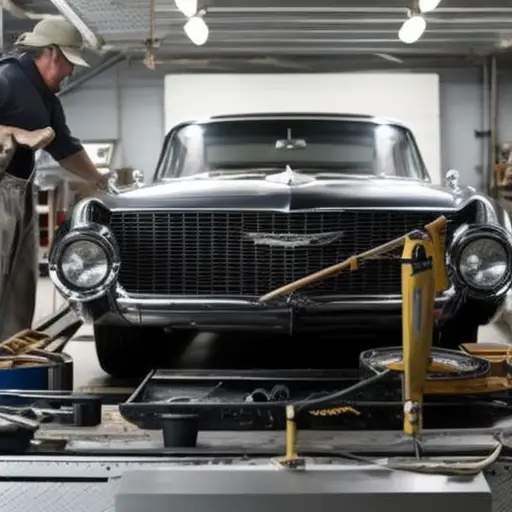Restoring a Car’s Electrical System: Tips and Tricks

While restoring a car’s electrical system may seem daunting, with the right knowledge and tools, it can be a rewarding and achievable task. In this article, we will explore practical tips and tricks for understanding, troubleshooting, and upgrading a vehicle’s electrical system.
From identifying common issues to testing and troubleshooting methods, this comprehensive guide will equip you with the essential know-how to effectively restore and maintain your car’s electrical system for improved performance.
Understanding the Electrical System
The electrical system of a car consists of various components that play a crucial role in ensuring proper functionality and performance. Understanding circuits is fundamental to comprehending the electrical system of a car.
Circuits in a car’s electrical system are pathways through which electricity flows. These circuits power various components such as lights, sensors, and the ignition system.
Voltage regulation is another essential aspect of the electrical system. The voltage regulator ensures that the power supplied to the different electrical components remains consistent, preventing damage from voltage spikes. It achieves this by regulating the alternator output. Understanding how voltage regulation works is critical in maintaining the health of the electrical system.
Proper voltage regulation enhances the longevity of electrical components and prevents electrical failures. In essence, a comprehensive understanding of circuits and voltage regulation is imperative for maintaining and troubleshooting a car’s electrical system.
This knowledge empowers car owners to identify and rectify electrical issues efficiently, ensuring the smooth operation of the vehicle.
Identifying Common Issues
How can one effectively pinpoint common electrical issues within a car’s system?
Troubleshooting techniques are essential in identifying and resolving common electrical problems in a car. One of the most common symptoms of electrical issues in a car is dim or flickering lights. This can indicate problems with the battery, alternator, or wiring.
Another common issue is difficulty starting the car, which may point to a faulty starter motor or a weak battery. Inconsistent power windows or central locking systems can signal wiring or switch problems.
Additionally, if the dashboard warning lights are frequently illuminated, it could indicate a range of electrical issues, such as a faulty sensor or a failing alternator.
A systematic approach to troubleshooting is crucial in identifying the root cause of these common symptoms. This includes conducting voltage tests, inspecting wiring for damage, and using diagnostic tools to pinpoint specific faults.
Essential Tools for Restoration
After identifying common electrical issues in a car’s system, the next step is to equip oneself with the essential tools for restoration, ensuring that the troubleshooting process is efficient and effective. Tool organization is crucial for a smooth restoration process.
A toolbox with compartments and dividers can help keep tools organized and easily accessible, saving time and reducing frustration during the restoration process. Additionally, labeling tools and having a designated workspace for each type of tool can further streamline the restoration process.
Safety precautions are paramount when working on a car’s electrical system. Essential safety tools such as insulated gloves, safety goggles, and a fire extinguisher should always be on hand. Insulated gloves provide protection against electric shock, while safety goggles shield the eyes from any debris or sparks that may occur during the restoration process. A fire extinguisher is a vital safety tool in case of an electrical fire.
Ensuring that these safety tools are readily available and in good condition is essential for a safe and successful restoration process.
Step-by-Step Wiring Inspection
Having equipped oneself with essential tools and safety precautions, the next step in restoring a car’s electrical system involves conducting a step-by-step wiring inspection to identify and address any potential issues. This critical process ensures that the car’s electrical system functions optimally and safely.
Here are the key steps to conduct a comprehensive wiring inspection:
-
Visual Inspection: Begin by visually examining the entire wire harness for any signs of damage, such as fraying, cuts, or exposed wires. This includes inspecting the wiring around the engine bay, under the dashboard, and throughout the vehicle.
-
Check for Corrosion: Look for any signs of corrosion on the wiring connectors, terminals, and fuse boxes. Corrosion can impede electrical flow and cause connectivity issues.
-
Testing for Continuity: Use a multimeter to test for continuity along the wiring harness and individual wires. This helps identify any breaks or interruptions in the wiring that may not be visible during a visual inspection.
-
Inspect Grounding Points: Ensure that all grounding points are clean, secure, and free from corrosion to maintain proper electrical grounding.
After completing the step-by-step wiring inspection, the next section will delve into cleaning and maintenance techniques to further enhance the car’s electrical system.
Cleaning and Maintenance Techniques
Regularly maintaining and cleaning the car’s electrical components is essential for ensuring long-term functionality and reliability. Cleaning techniques play a crucial role in preventing corrosion and ensuring optimal conductivity within the electrical system.
When performing preventive maintenance on the car’s electrical system, it is important to use appropriate cleaning products and tools. For connectors and terminals, a specialized electrical contact cleaner can effectively remove dirt, grease, and other contaminants that may impede electrical flow. It is advisable to gently scrub the components with a small wire brush to ensure thorough cleaning without causing damage. Additionally, dielectric grease can be applied to the connectors after cleaning to protect against moisture and corrosion.
When cleaning wiring harnesses, using a mild detergent and water solution can help remove dirt and grime without harming the insulation. After cleaning, it is important to thoroughly dry the components to prevent any moisture-related issues.
Testing and Troubleshooting Methods
To ensure the optimal functionality and reliability of a car’s electrical system, employing thorough testing and troubleshooting methods is essential. This ensures that any underlying issues are identified and resolved promptly, preventing potential breakdowns and safety hazards.
Here are some effective methods for testing and troubleshooting car electrical systems:
-
Voltage Testing: Utilize a multimeter to measure the voltage at various points in the electrical system, such as the battery, alternator, and individual components, to ensure that the correct voltage levels are being maintained.
-
Continuity Checking: Use a multimeter to check for continuity in electrical circuits, ensuring that there are no breaks or open circuits that could impede the flow of electricity.
-
Grounding Issues: Investigate and address any grounding issues that may be causing electrical malfunctions, such as corroded or loose ground connections, which can disrupt the proper flow of electricity.
-
Circuit Tracing: Trace the path of electrical circuits to identify any faults or issues, such as damaged wiring or faulty connections, enabling targeted repairs to be carried out efficiently.
Upgrading for Improved Performance
Upgrading for improved performance within the car’s electrical system necessitates a comprehensive understanding of its existing components and their interactions, as well as a keen awareness of potential areas for enhancement.
Performance enhancement can be achieved through strategic electrical modifications that optimize power distribution, reduce energy loss, and enhance overall efficiency.
One approach to upgrading for improved performance is the installation of high-performance ignition systems, which can significantly improve engine power and fuel efficiency.
Additionally, upgrading to a high-output alternator can ensure a stable power supply for the vehicle’s electrical components, particularly in high-demand situations.
Upgrading the wiring harness with high-quality, low-resistance wires can minimize voltage drops and improve the overall electrical conductivity, resulting in enhanced performance.
Furthermore, integrating advanced electronic control modules and performance-oriented sensors can fine-tune the engine’s operation, maximizing power output while maintaining fuel economy.
Careful consideration of these performance-oriented upgrades and electrical modifications can lead to substantial improvements in the overall functionality and efficiency of the car’s electrical system.
Frequently Asked Questions
Can I Restore a Car’s Electrical System Without Any Prior Experience or Knowledge of Car Mechanics?
Restoring a car’s electrical system without prior experience or knowledge of car mechanics is possible with basic troubleshooting techniques. However, it’s crucial to avoid common mistakes, seek guidance, and consider professional assistance for complex issues.
What Are Some Lesser-Known Signs of Electrical Issues in a Car That I Should Look Out For?
Common symptoms of electrical issues in a car include flickering lights, electrical accessories not working, and dim headlights. A thorough troubleshooting process involving checking fuses, wiring, and the battery can help identify and resolve these issues.
How Do I Prevent Electrical System Issues From Recurring After Restoration?
To prevent electrical system issues from recurring after restoration, it is essential to prioritize preventive maintenance by regularly inspecting wiring, connectors, and components. Additionally, employing effective troubleshooting techniques can help identify and address potential problems early on.
Are There Any Specific Safety Precautions I Should Take When Working on a Car’s Electrical System?
When working on a car’s electrical system, specific safety precautions are necessary for protection. Essential tools, knowledge of electrical system basics, and emergency procedures are vital. Prioritizing safety is akin to wearing a seatbelt while driving.
What Are Some Advanced Upgrades I Can Make to Improve the Performance of My Car’s Electrical System?
When looking to make advanced modifications to enhance the performance of a car’s electrical system, consider upgrading to high-performance alternators, installing a dual battery system, and incorporating advanced voltage regulators for improved power management and reliability.
Conclusion
In conclusion, restoring a car’s electrical system is like solving a complex puzzle, requiring careful inspection, cleaning, and testing.
By understanding the system, identifying common issues, and using essential tools, one can successfully restore and upgrade the electrical system for improved performance.
With patience and attention to detail, one can bring a car’s electrical system back to life, just like a skilled craftsman restoring a masterpiece.





